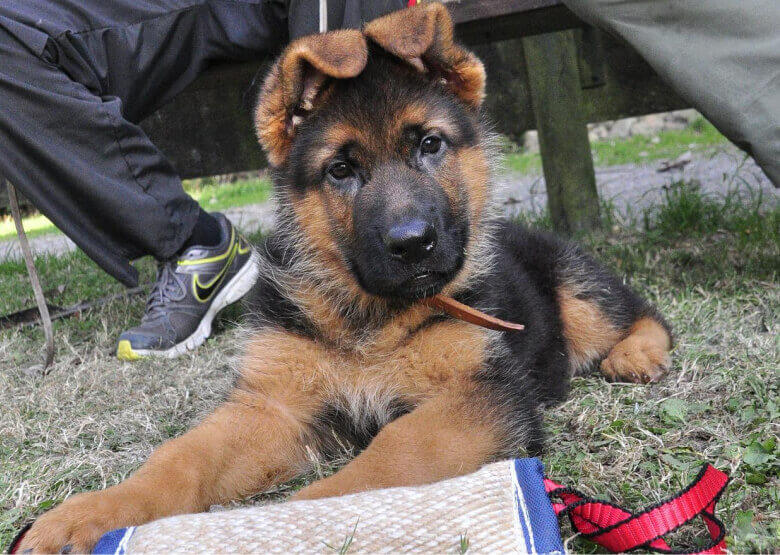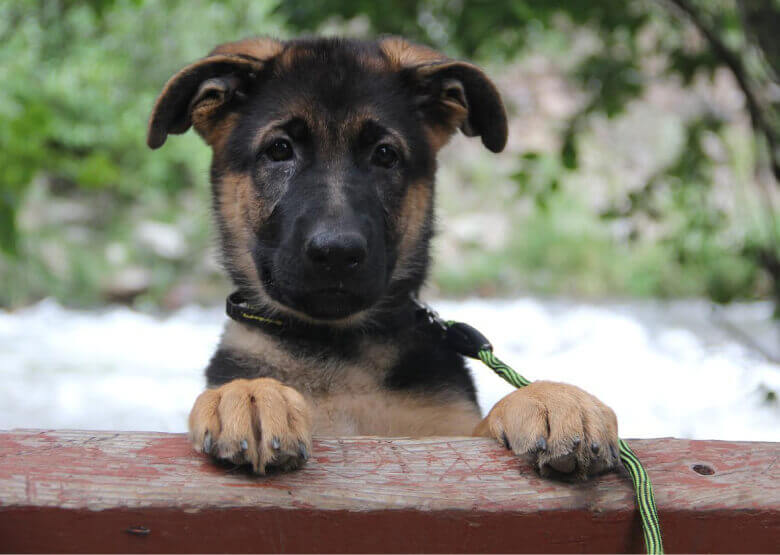Table of Contents
A thick-bellied and thick-legged cub of a Shepherd color with a long tail and dense fur can only be finally classified as purebred when the ears of a German Shepherd puppy stand up.
The ears of a true German Shepherd are, according to the standard, erect, of the medium size, set high, with the ends directed forward and up, and not adjacent to the skull on both sides, even when a Shepherd dog is in motion or presses its ears or lowers them in a calm position. This ‘opening’ of the ears is not a disadvantage.
When German Shepherd ears stand up when excited, the distance between their highest points (tips) should visually equal the width of the auricle.
Why Do Shepherds Have Such Ears?
The deep and voluminous auricle of a German Shepherd is a mobile locator that sensitively picks up sounds at a frequency of more than 30,000 Hz and a distance much greater than a human’s ear can hear.
Since the range of frequencies heard by a dog is much higher than that of a human, a German Shepherd determines the source of the sound and its direction and location instantly and accurately due to such an auricle at a distance of 25-50 m (depending on the pitch of the sound). Moreover, a Shepherd can hear the peals of thunder or the sound of a working chainsaw at a distance of 9-12 km.
Let’s consider the facts for comparison. The lowest sound for a human is 16 Hz, while the highest one is 20 thousand Hz. The upper limit of frequency fluctuations perceived by a GS dog as a sound is 80-100 thousand Hz.
Clear hearing is especially important for a German Shepherd as for a dog with high service qualities and no less high requirements for its work.
Sensitive ears allow not only for relying on a Shepherd dog as an excellent guard but also for guiding it at great distances, giving commands at frequencies that are not perceived by the human ear or in an undertone.
‘Anatomy’ of the Ear

All Shepherd dogs are born blind and deaf, and they may seem so imperfect.
Their small ears are also imperfect – they are rather soft due to the underdeveloped cartilage that makes up the auricle. That is why there are separate German Shepherd puppy ears stages when they start standing up. The soft and weak cartilage grows, strengthens, and increases in size along with the puppy’s whole body, turning into an elastic cartilage plate that does not have blood vessels.
The cartilaginous plate is covered on both sides with a layer of thin connective tissue that provides the main cartilage with growth and nutrition and is called the perichondrium. The perichondrium, on the contrary, is dotted with mini-hematopoietic capillaries and blood vessels. Through them, the cartilage receives necessary substances for its growth and compaction with the help of conventional diffusion (literally, penetration by contact).
In the same way, the ear cartilage of a GS dog is built on, and the perichondrium has semi-stem cells which, like bricks, are built into the cartilage tissue.
The puppy’s ears do not stand up until the perichondrium has completed the main cartilage to the necessary density.
Cartilage cells, in turn, produce collagen and elastin. The strength of Shepherd’s auricle depends on them – the cartilage density increases due to the addition of new layers on both sides of the perichondrium.
Young German Shepherd puppies’ ears seem unnecessarily large for their head. This is due to the active work of all parts of the auricle (cartilage and perichondrium). From 2 to 4 months, there is an active reproduction of collagen, the ear actively increases in size, becoming, as it were, ‘for growth’. The scheme of superstructures that increase the growth and strength of the cartilage is observed throughout the first period of the puppy’s growth when its overall size also increases significantly, though the ears still remain hanging.
Up to 4 months, cartilage tissues are especially active, but by the fifth month, the growth of elastic layers and the embedding of stem cells decreases. Having reached a certain density, ear growth slows down, and in a short time, it almost diminishes.
The metabolism in the auricle becomes so low that visually the ear seems to no longer grow. However, limited living processes in it continue throughout life. Otherwise, it would be impossible to restore the tissues of the German Shepherd puppy ears in case of damage.
What Is Necessary for the Correct Formation of the Cartilage Plate and Development of the Perichondrium?

First of all, it is important to provide the cells of cartilage tissues with nutrition so that they can ‘build up’. To do this, you need to feed the puppy a balanced diet with enough calcium and phosphorus.
Be very attentive because mineral supplements with a high content of these substances are strongly not recommended for independent use if you want to quickly make German Shepherd puppies’ ears stand up.
Excess calcium and phosphorus can adversely affect the formation of the ear cartilage and the development of the musculoskeletal system of a German Shepherd.
We must not forget about the composition of the blood because it is the main food for the growth and strengthening of the cartilage plate due to the diffuse contact with it via the perichondrium.
Not only nutrition but also the obligatory physical activity of a German Shepherd puppy, both at home and on walks, help improve the blood supply to the perichondrium.
Under such keeping conditions, the ears of the Shepherd stand up on time and additional actions on the part of an owner are not required.
When Do German Shepherd Ears Stand Up and Why Doesn’t It Sometimes Happen?

The optimal age when the ears should stand up is 5 months.
Do not be afraid if the ears are 1.5-2 months late. This sometimes happens.
You need to worry if the puppy is already 8 months old, and the ears still do not rise. 10 months is a critical age for setting ears.
If at the age of 12 months, the ears are still not on top, the question of a purebred puppy will emerge.
Teeth and Ears
It often happens that at 2-3 months the ears of a Shepherd stood up, and at 4 they fell (one or two at once) This is a normal process associated with the change of teeth, when the body mobilizes all the microelements to build a strong dental system, pulling phosphorus and calcium front he cartilage in this direction.
The change of teeth in a German Shepherd is considered complete when real fangs with a wide base appear in the mouth and all molars erupt – it’s by about 7 months of age. At the same time, the drooping ears should stand up.
Molar growth continues up to 8, maximum 9 months, still pulling calcium and phosphorus for the teeth construction (tooth enamel consists of more than 90% of these inorganic elements), but if, with the appearance of all necessary 42 permanent teeth, ear cartilage is still not able to lift the ear, it is worth contacting a veterinarian.
Hurry up! After a year, hopes to put up ears in a German Shepherd are melting exponentially.
Appointment with a Doctor

If you came to the appointment with a veterinarian with a question, ‘The German Shepherd ears don’t stand up – what to do?’, the doctor, upon the examination, will ask you a number of questions:
- Did the puppy have acquired or birth injuries of the ears/auricles? There may be, for example, a birthing crease, subluxation, or hematoma as a result of injury to the ear canal.
- Has your dog ever had ear infections or other ear problems? They can involve inflammation of the middle ear, otodectosis, or a forest tick attack.
- Have you noticed any allergic reactions in your pet? It may be allergic to dairy products or antibiotics.
- If antibiotics or immunomodulators were used, what did your dog get sick with, and how often? Infectious diseases significantly inhibit the development of a Shepherd dog and slow down growth and physiological formation, including cartilage tissues. The latter is in charge of whether the ears of a GS puppy will stand up or it will remain floppy-eared.
- In what conditions is the young Shepherd kept? When living in an aviary, a dog must have a warmed booth in winter (to avoid hypothermia of the ears, leading to spasms of small vessels of the perichondrium) and a dense canopy from the sun in summer – overheating also leads to spasms.
- Do you walk and talk enough to your dog? A sedentary lifestyle, as well as a lack of physical and emotional activity, can be a good reason why your dog’s ears are not standing.
- What bio-feeds did you use during the puppy’s growth period? Each age demands its own supplements developed for puppies, and they are also divided by the size of the dogs: small, medium, and large dogs. The German Shepherd is a large breed!
- Do any of the puppy’s parents have hormonal imbalances? This is one of the most common problems in pedigree dogs, including German Shepherds. Diseases associated with the imbalance of hormones lead to problems with the immune system and prevent the body from proper formations of all organs and their functions. Hence, difficulties arise when German Shepherd puppies’ ears stand up.
- Do you keep track of your dog’s age-height-weight ratio? Overfeeding a German Shepherd (as well as underfeeding) leads to a deficiency of micro-and macroelements, which highly contributes to the timely formation of cartilage tissues by the age when the Shepherd should raise its ears.
- Have there been any stressful situations? Cortisol, a stress hormone, activates a defense mechanism that blocks the production of new cells (including semi-stem cells in cartilage tissues), reduces blood flow, and forms a negative calcium balance in the body of a Shepherd dog.
- Did the puppy’s parents have problems with ear placement? Very often, this problem is transmitted at the genetic level, and your German Shepherd floppy ears can be a result of it.
- When was the last vaccination administered? After vaccination, the body of a GS dog begins the active formation of immunity. The process requires the consumption of microelements and vitamins for biochemical reactions, so their deficiency is formed, similar to the condition after an illness.
- How often do you pet your puppy on the head? At your touch, the Shepherd dog instinctively lays its ears back, getting used to keeping them folded lengthwise from the base to the top. The result will be an acquired crease or scar along with the entire ear that keeps the German Shepherd ears down, and this will require cartilage adjustment. Don’t pet your Shepherd’s ears!
If the doctor sees it necessary, your pet will have to take a blood test, undergo an ultrasound, and possibly take some x-rays.
Treatment
Based on the results of the examination, the doctor will prescribe medicines (most often – flavonoids, vitamins, glucosamine, calcitonin, thyroxine, iodine, zinc, iron, manganese, copper, and magnesium), which normalize the composition of the blood and add the necessary building material to the body.
It is important to carry out all the medicinal prescriptions under the supervision of a veterinarian. An overabundance of any element can lead to a deterioration in the general condition of the pet and its ears in particular.
In addition to medication, the doctor will most likely prescribe an ear massage at home.
The massage procedure is not complicated – knead the ear from the base to the very tip between the thumb and forefinger, helping to improve blood supply, for about 5 minutes, 3-4 times a day.
Be careful with the place where the ear is attached to the head! This place does not need to be kneaded, only the auricle itself!
The fingers will get tired, and it’s inevitable. Though, the most favorable result will not be long in coming – the ears of Shepherd dogs stand up in just a week or two.
It is worse if the veterinarian makes a diagnosis of the atypical defect of the ear cartilage. What does it mean? Is it safe for the health of the Shepherd? And is it possible to put ears on a puppy with such a diagnosis?
Atypical Cartilage and Ways to Eliminate Consequences

Atypical cartilage is a defect in the development of the ear cartilage, resulting from a damaged structure of ear tissues, and their inability to support the ear in an upright position. So, when do German Shepherd puppies’ ears stand up with such a diagnosis?
Insufficiently strong, loose, and heavy cartilage fibers break due to the heterogeneity of the tissue (somewhere dense and flexible tissue is somewhere replaced with soft and ‘liquid’), and a crease or scar is formed on the ear at the transition point.
This often occurs in young dogs after the ears have stood up, and then an ear or even two has fallen off.
The same picture can be observed in old Shepherd dogs – the ear or both fall off and then rise again. The reason is the same – deformation of the ear cartilage due to long years of life at old age.
However, with the old GSs, it will no longer be possible to return the ears to a stable standing position. Nevertheless, it is quite possible to correct the position of the young German Shepherd ears – they need to be glued, allowing the cartilage to recover.
Gluing is nothing more than the necessary support for the intensive synthesis of elastin (a connective protein in tissues) and its uniform growth over the entire area of the ear cartilage.
Properly glued ears do not allow creases or folds, never stretch scars, and make it possible to fill these creases with full-fledged elastin within 1.5-2 months.
In this case, the puppy or young GS should be given maintenance vitamin supplements containing gelatin. Good results are also provided by a steep bone jelly or soaked food gelatin, 1 tbsp before every feeding.
Adding bone meal and sea fish to the diet is a good solution, too!
Taping Ears Correctly
Since when is it worth starting the taping process? Until 8-10 months of age, cartilage correction is unlikely to be needed. It is better to use the support in the form of massage and, possibly, a garter to put two ears together from 3-4 months of age so that they take the correct position on the head.
How to Determine If a Correction Is Needed?
Feel the ear from its base to tip. If you find a thinned place or a ‘liquid’ tissue, look for a convex scar in this place because the ear can be folded along it. If a crease or scar is found, you need to tape the ear urgently! You can watch some videos to see how to tape German Shepherd ears correctly.
What Should I Do If, After Taping or Adjusting, One Ear Does Not Stand or Falls Again?
To correct one non-standing ear if the cartilage is even and of good density, without creases and scars, you can resort to a cardboard or plastic insert that maintains the ear in the desired position. Watch some videos to see how to do that.
In any case, do not despair! It is possible to make German Shepherd puppies’ ears stand up before they reach one year of age if you put some effort into it.

